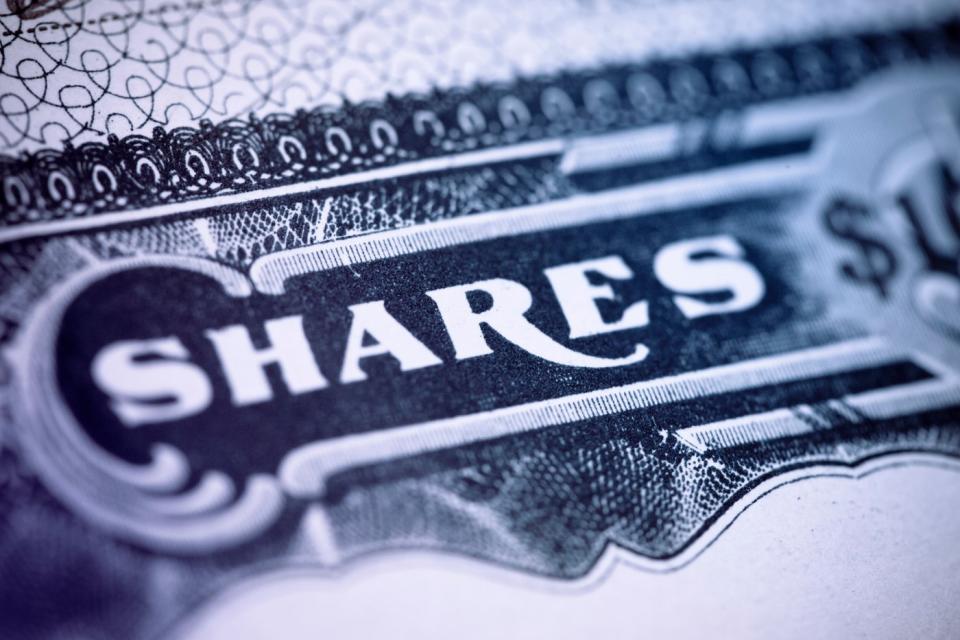
[ad_1]
Volatility is fully expected when putting your money to work on Wall Street. However, the past four years have been nothing short of a roller-coaster ride for investors.
The COVID-19 crash of February-March 2020 sliced away a third of the value of the benchmark S&P 500 in less than five weeks. We also witnessed the Dow Jones Industrial Average, S&P 500, and Nasdaq Composite dip into respective bear markets in 2022. Meanwhile, 2021 and 2023 featured periods of investment euphoria for the bulls.
During periods of turbulence, it’s not uncommon for investors to seek out outperforming stocks. For the past two and a half years, it’s stocks enacting splits that have fit the mold.

A stock split allows a publicly traded company to alter both its share price and outstanding share count without affecting its market cap or operating performance. It’s best thought of as a cosmetic tool used to make shares more nominally affordable for everyday investors (as with a forward-stock split), or to boost a company’s share price to ensure continued listing on a major stock exchange (as with a reverse-stock split). Most investors tend to focus on forward-stock splits, since they’re being conducted by high-flying companies that are out-executing their competition.
Since the midpoint of 2021, nine first-class companies have enacted stock splits:
-
Nvidia (NASDAQ: NVDA): 4-for-1 split
-
Amazon (NASDAQ: AMZN): 20-for-1 split
-
DexCom (NASDAQ: DXCM): 4-for-1 split
-
Shopify (NYSE: SHOP): 10-for-1 split
-
Alphabet (NASDAQ: GOOGL)(NASDAQ: GOOG): 20-for-1 split
-
Tesla (NASDAQ: TSLA): 3-for-1 split
-
Palo Alto Networks (NASDAQ: PANW): 3-for-1 split
-
Monster Beverage (NASDAQ: MNST): 2-for-1 split
-
Novo Nordisk (NYSE: NVO): 2-for-1 split
With these industry-leading businesses handily outpacing the S&P 500 over lengthy periods, investors are eager to know what companies may be next to join their ranks. While nothing is written in stone, the following three companies could be the next stock-split stocks in 2024.
Broadcom
The first potential stock-split stock of 2024 is semiconductor behemoth Broadcom (NASDAQ: AVGO), which is currently setting its shareholders back nearly $1,122 per share. Although Broadcom had split its stock on a handful of occasions prior to being acquired by Avago in 2016 (Avago kept the Broadcom name after the buyout), Avago has never conducted a stock split of its own. The new year could be the perfect occasion.
What’s primarily powered Broadcom higher in 2024 is the opportunity that lies ahead with artificial intelligence (AI).
In April, the company debuted its Jericho3-AI chip, which has the potential to revolutionize high-compute data centers. Jericho3-AI can connect up to 32,000 graphics processing units at once, which is necessary for the split-second decision-making required by AI-powered software and systems. According to researchers at PwC, AI is expected to add $15.7 trillion to global gross domestic product by 2030.
In addition to Broadcom’s massive potential in AI, the company is firing on all cylinders thanks to the 5G revolution. Despite some general softness in smartphone sales in 2023, Broadcom generates a significant percentage of its revenue from the wireless chips and accessories found in next-generation smartphones. Access to faster download speeds should encourage a relatively steady device replacement cycle, which, along with the company’s healthy backlog, can power its stock even higher.
Chipotle Mexican Grill
A second well-known company that could be the next stock-split stock in 2024 is fast-casual restaurant chain Chipotle Mexican Grill (NYSE: CMG). Since its initial public offering at $22 per share in January 2006, Chipotle has conducted no splits and soared to a jaw-dropping $2,304 per share. Select retail investors without access to fractional-share purchases may need a forward split if they have any hope of owning a stake in this outperformer.
Chipotle’s success can be boiled down to three factors. The first of those is its reliance on fresh, and predominantly locally sourced, ingredients. Chipotle has demonstrated that an operating model catered to healthier foods and meat sourced from animals with no added hormones or non-therapeutic antibiotics resonates with consumers.
The second catalyst for Chipotle, which builds on its sourcing commitments, is its pricing power. Just as the healthier foods craze of the early 2000s encouraged grocery shoppers to open their wallets a bit wider, Chipotle has realized that its customers are willing to pay more for locally sourced foods and meats from responsibly raised animals. A higher prevailing inflation rate has only fueled sales growth for the company.
The third factor that’s made Chipotle a sizzling investment and pushed its share price to north of $2,300 is its innovation. Though introducing new and limited food items has successfully drawn in new customers, it’s the company’s out-of-the-box innovation that’s really helped it shine. For instance, it began experimenting with digital order drive-throughs, known as “Chipotlanes,” in 2018. This concept has taken off and is helping to boost average ticket prices and expedite order flows.

Costco Wholesale
The third widely owned company that can be the next stock-split stock in 2024 is warehouse club Costco Wholesale (NASDAQ: COST). Costco has split its shares three times since going public, but it’s been close to 24 years since its last stock split. A single share of Costco will set investors back almost $672.
Costco’s biggest advantage is simply being big. Having deep pockets and generating north of $13 billion in operating cash flow over the trailing 12 months means Costco can buy items in bulk. Purchasing goods in bulk usually leads to each item costing less. This allows Costco to undercut traditional grocery stores and mom-and-pop shops on price, which is one of its biggest lures.
Another reason for its long-term success is its membership-driven operating model. Charging $60 or $120 annually to members to shop at its warehouses generates boatloads of cash flow that Costco is able to use to sustain its lower prices. Furthermore, charging people for a membership encourages those users to stay within its ecosystem of products and services. Members want to get the most they can out of that $60 to $120 annual fee.
Lastly, don’t overlook the obvious: Costco provides basic need goods. Though the company counts on its members making higher-margin discretionary purchases, it’s the simple fact that it sells groceries, toiletries, and other basic need items that will continually draw in customers in any economic climate.
Costco Wholesale should close out 2023 with its 19th positive annual total return, including dividends paid, over the past 22 years.
Should you invest $1,000 in Broadcom right now?
Before you buy stock in Broadcom, consider this:
The Motley Fool Stock Advisor analyst team just identified what they believe are the 10 best stocks for investors to buy now… and Broadcom wasn’t one of them. The 10 stocks that made the cut could produce monster returns in the coming years.
Stock Advisor provides investors with an easy-to-follow blueprint for success, including guidance on building a portfolio, regular updates from analysts, and two new stock picks each month. The Stock Advisor service has more than tripled the return of the S&P 500 since 2002*.
*Stock Advisor returns as of December 18, 2023
John Mackey, former CEO of Whole Foods Market, an Amazon subsidiary, is a member of The Motley Fool’s board of directors. Suzanne Frey, an executive at Alphabet, is a member of The Motley Fool’s board of directors. Sean Williams has positions in Alphabet and Amazon. The Motley Fool has positions in and recommends Alphabet, Amazon, Chipotle Mexican Grill, Costco Wholesale, Monster Beverage, Nvidia, Palo Alto Networks, Shopify, and Tesla. The Motley Fool recommends Broadcom, DexCom, and Novo Nordisk. The Motley Fool has a disclosure policy.
These 3 Companies Can Be the Next Stock-Split Stocks in 2024 was originally published by The Motley Fool
[ad_2]